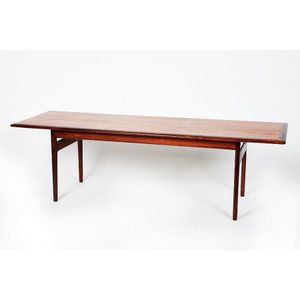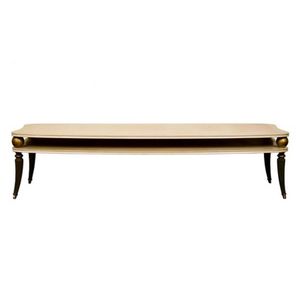Limed Oak Coffee Table by O. Noel Coulson (1958)
You must be a subscriber, and be logged in to view price and dealer details.
Subscribe Now to view actual auction price for this item
When you subscribe, you have the option of setting the currency in which to display prices to $Au, $US, $NZ or Stg.
- Oak - Native to Europe and England, oak has been used for joinery, furniture and building since the beginning of the medieval civilisation. It is a pale yellow in colour when freshly cut and darkens with age to a mid brown colour.
Oak as a furniture timber was superceded by walnut in the 17th century, and in the 18th century by mahogany,
Semi-fossilised bog oak is black in colour, and is found in peat bogs where the trees have fallen and been preserved from decay by the bog. It is used for jewellery and small carved trinkets.
Pollard oak is taken from an oak that has been regularly pollarded, that is the upper branches have been removed at the top of the trunk, result that new branches would appear, and over time the top would become ball-like. . When harvested and sawn, the timber displays a continuous surface of knotty circles. The timber was scarce and expensive and was used in more expensive pieces of furniture in the Regency and Victorian periods. - Limed / Cerused Finish - A process for finishing timber whereby the surface was covered with a coating of lime, which was subsequently brushed from the surface, but allowed to remain in the grain. The resulting surface with its streaking and speckling of white was usually left unpolished. The finish was popular for French furniture in the late 19th century, and English cottage style furniture in the early 20th century. Oak timber was popular for liming because its open grain retained a larger amount of the lime than other close grained timbers.
Nowadays the same effect can be achieved by use of paint, or proprietry solutions for "liming".
This item has been included into following indexes:
Visually similar items

Philippe Starck (French b. 1949), flat egg table cast aluminium frame and glass. Provenance: Private Collection, NSW

Antonio Citterio Charles coffee table for B&B Italia, grey finish on polished aluminium legs, Italy, c 2000s

A Greta Grossman teak bench by Glen group, California c.1955. Height 41.5 cm. Width 46 cm. Depth 165 cm

Attributed to Johannes Andersen (Danish), Coffee Table, c. 1960, manufactured by CFC Silkeborg, rosewood, retains manufacturer's label, height 50 cm with 165 cm depth 50 cm
